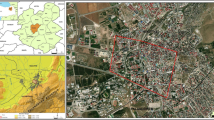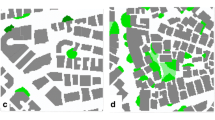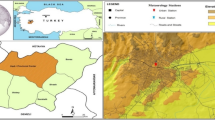Abstract
With the rapid rise in population density in urban areas, there has also been an increase in research on quality of life and the effects of green space on health and comfort in densely populated cities. A critical part of improving the quality of life in urban areas is the reduction of urban heat island effect, especially in hot climate cities, and the reduction of adverse effects of winter in cold climates. Urban planning and landscape design strategies can have a great impact on urban microclimates, thereby providing relief from the harsh effects of climate change. Studies reveal that the cultivation of wetlands and open green spaces can have a direct impact on microclimate and comfort in densely populated areas. Erzurum is under the cold stress of the decreasing temperature in winter and continues to experience extreme temperatures in summer. This study is focused on the effects of urban design and landscape architectural interventions in the city of Erzurum. For this purpose, meteorological stations were placed in intensive construction areas of the urban city center, in wetland areas, and in the forested area of Ata Botanical Park in the city center. Three stations, dense green areas (1), temporary wetlands (2), and urban city center areas (3), were selected as urban area use types. Meteorological data were collected during March–April when the wetlands were full due to heavier periods of rain, and during July–August, the hottest months in the city. Thermal comfort values have been analyzed for different areas using RayMan soft model. The average value of Physiologically Equivalent Temperature (PET) recorded in March–April was 3.5 °C in the city center, 2.8 °C in the dense green area, and − 0.3 °C around the temporary wetland area. In July and August, the average value of PET in the city center was 24.9 °C, 23.0 °C in dense green areas, and 21.2 °C around the wetland area. In cold cities, it was found that the water surfaces, which positively contribute to thermal comfort in summer, increased the cold stress in winter. It was determined that dense green areas function as balancing factors for thermal comfort of the city both for summer and winter seasons and they contributed positively in all conditions. As a result of this study, more accurate decisions can be made for future urban planning efforts by considering the effects of different environmental conditions on microclimates in the city, especially where this consideration can be applied to urban design and development, urban revitalization efforts, or when designing new settlements.














Similar content being viewed by others
References
Abdi B, Hami A, Zarehaghi D (2020) Impact of small-scale tree planting patterns on outdoor cooling and thermal comfort. Sustainable Cities and Society, 56, Article in press, 102085
Afshar NK, Karimian Z, Doostan R, Nokhandan MH (2018) Influence of planting designs on winter thermal comfort in an urban park. J Environ Eng Landsc Manag 26(3):232–240
Anonymous (2018) Turkish State Meteorological Service (MGM). https://www.mgm.gov.tr/. Data of Ministry of Agriculture and Forestry, General Directorate of Meteorology, Ankara
ASHRAE, (American Society of Heating, Refrigerating and Air Conditioning Engineers) (1992) Thermal environmental conditions for human occupancy. ANSI/ASHRAE standards, Atlanta
Balczó M, Gromke C, Ruck B (2009) Numerical modeling of flow and pollutant dispersion in street canyons with tree planting. Meteorol Z 18(2):197–206
Bowler DE, Buyung-Ali L, Knight TM, Pullin AS (2010) Urban greening to cool towns and cities: a systematic review of the empirical evidence. Landsc Urban Plan 97(3):147–155
Carol E, Braga F, Lio CD, Kruse E, Tosi L (2015) Environmental isotopes applied to the evaluation and quantification of evaporation processes in wetlands: a case study in the Ajó Coastal Plain wetland, Argentina. Environ Earth Sci 74:5839–5847
Cartalis C, Synodinou A, Proedrou M, Tsangrasouli A, Santamouri M (2001) Modifications in energy demand in urban areas as a result of climate changes: an assessment for the Southeast Mediterranean region. Energy Conversation Manag 42:1647–1656
Cheung PK, Jim CY (2018) Comparing the cooling effects of a tree and a concrete shelter using PET and UTCI. Build Environ 130:49–61
Chen L, Wen Y, Zhang L, Xiang W (2015) Studies of thermal comfort and space use in an urban park square in cool and cold seasons in Shanghai. Build Environ 94:644–653
Depietri Y, Renaud FG, Kallis G (2012) Heat waves and floods in urban areas: a policy-oriented review of ecosystem services. Integr Res Syst Sustain Sci Sustain Sci 7:95–107
Du H, Song X, Jiang H, Kan Z, Wang Z, Cai Y (2016) Research on the cooling island effects of water body: a case study of Shanghai, China. Ecol Indic 67:31–38
Eppinka FV, Bergha J, Rietveldb P (2004) Modelling biodiversity and land use: urban growth, agriculture and nature in a wetland area. Ecol Econ 51:201–216
Erell E, Pearlmutter D, Williamson T (2012) Urban microclimate: designing the spaces between buildings. Earthscan
Fanger PO (1970) Thermal comfort. Danish Technical Press, Copenhagen 244 pp
Fröhlich D, Gangwisch M, Matzarakis A (2019) Effect of radiation and wind on thermal comfort in urban environments-application of the RayMan and SkyHelios model. Urban Clim 27:1–7
Fung CK, Jim CY (2020) Influence of blue infrastructure on lawn thermal microclimate in a subtropical green space. Sustain Cities Soc 52:101858 inpress
Gill SE, Handley JF, Ennos AR, Pauleit S (2007) Adapting cities for climate change: the role of the green infrastructure. Built Environ 33(1):115–133
Gulyas A, Unger J, Matzarakis A (2006) Assessment of the microclimatic and human comfort conditions in a complex urban environment: modelling and measurements. Build Environ 41(12):1713–1722
Höppe P (2002) Different aspects of assessing indoor and outdoor thermal comfort. Energy Build 34(6):661–665
Hsieh CM, Jan FC, Zhang L (2016) A simplified assessment of how tree allocation, wind environment, and shading affect human comfort. Urban Forestry Urban Green 18:126–137
Irmak MA, Yilmaz S, Dursun D (2017) Effect of different pavements on human thermal comfort conditions. Atmósfera 30(4):355–366
Javanroodi K, Nik VM (2020) Interactions between extreme climate and urban morphology: investigating the evolution of extreme wind speeds from mesoscale to microscale. Urban Clim 31:100544 inpress
Jongtanom Y, Kositanont C, Baulert S (2011) Temporal variations of urban heat island intensity in three major cities, Thailand. Mod Appl Sci 5:105–110
Klemm W, Heusinkveld BG, Lenzholzer S, Jacobs MH, van Hove B (2015) Psychological and physical impact of urban green spaces on outdoor thermal comfort during summertime in The Netherlands. Build Environ 83:120–128
Kong L, Lau KKL, Yuan C, Chen Y, Xu Y, Ren C, Ng E (2017) Regulation of outdoor thermal comfort by trees in Hong Kong. Sustain Cities Soc 31:12–25
Kottek M, Grieser J, Beck C, Rudolf B, Rubel F (2006) World map of the Köppen-Geiger climate classification updated. Meteorol Z 15(3):259–263
Laird NF, Kristovich DAR, Liang XZ, Arritt RW, Labas K (2001) Lake Michigan lake breezes: climatology, local forcing, and synoptic environment. J Apply Meteorol 40:409–424
Lee H, Mayer H, Chen K (2016) Contribution of trees and grasslands to the mitigation of human heat stress in a residential district of Freiburg, Southwest Germany. Landsc Urban Plan 148:37–50
Matzarakis A, Mayer H, Iziomon MG (1999) Applications of a universal thermal index: physiological equivalent temperature. Int J Biometeorol 43(2):76–84
Matzarakis A, Rutz F (2005) Application of RayMan for tourism and climate investigations. Ann Meteorol 41(2):631–636
Matzarakis A, Nastos PT (2011) Human-biometeorological assessment of heat waves in Athens. Theoredical Apply Climatol 105(1-2):99–106
Memon RA, Leung DYC, Chunho L (2008) A review on the generation, determination and mitigation of urban heat island. J Environ Sci 20:120–128
Mirzaei PA, Haghighat F (2010) Approaches to study urban heat island–abilities and limitations. Build Environ 45(10):2192–2201
Nakayama T, Fujita T (2010) Cooling effect of water-holding pavements made of new materials on water and heat budgets in urban areas. Landsc Urban Plan 96:57–67
Nikolopoulou M, Lykoudis S (2006) Thermal comfort in outdoor urban spaces: analysis across different European countries. Build Environ 41(11):1455–1470
Nowak DJ (2002) The effects of urban trees on air quality. US Department of Agriculture Forest Service, Washington, pp 96–102
Oke TR, Johnson DG, Steyn DG, Watson LD (1991) Simulation of surface urban heat island under ‘ideal’ conditions at night – part 2: diagnosis and causation. Bound. Layer Meteorol 56:339–358
Potchter O, Cohen P, Lin TP, Matzarakis A (2018) Outdoor human thermal perception in various climates: a comprehensive review of approaches, methods and quantification. Sci Total Environ 631:390–406
Qaid A, Lamit HB, Ossen DR, Shahminan RNR (2016) Urban heat island and thermal comfort conditions at micro-climate scale in a tropical planned city. Energy Build 133:577–595
Shen T, Chow DHC, Darkwa J (2013) Simulating the influence of microclimatic design on mitigating the urban heat island effect in the Hangzhou Metropolitan Area of China. Int J Low Carbon Technol 11(1):130–139
Stone B, Vargo J, Liu P, Habeeb D, DeLucia A, Trail M, Hu Y, Russell A (2014) Avoided heat-related mortality through climate adaptation strategies in three US cities. Plos One 9(6):e100852. https://doi.org/10.1371/journal.pone.0100852
Sun S, Xu X, Lao Z, Liu W, Li Z, García EH, Zhu J (2017) Evaluating the impact of urban green space and landscape design parameters on thermal comfort in hot summer by numerical simulation. Build Environ 123:277–288
Synnefa A, Santamouris M, Apostolakis K (2007) On the development, optical properties and thermal performance of cool colored coatings for the urban environment. Sol Energy 81:488–497
Takebayashi H, Moriyama M (2009) Study on the urban heat island mitigation effect achieved by converting to grass-covered parking. Sol Energy 83(8):1211–1223
Tan Z, Lau KK, Ng E (2016) Urban tree design approaches for mitigating daytime urban heat island effects in a high-density urban environment. Energy Build 114:265–274
Toy S, Yilmaz S (2010) Thermal sensation of people performing recreational activities in shadowy environment: a case study from Turkey. Theoredical Appl Climatol 101(3-4):329–343
United Nations (2018) Department of Economic and Social Affairs, News, Unated Nations DESA. https://www.un.org/development/desa/en/news/population/2018-revision-of-world-urbanization-prospects.html
Unger J (1999) Comparisons of urban and rural bioclimatological conditions in the case of a Central-European city. Int J Biometeorol 43(3):139–144
Wang Q, Wang Y, Fan Y, Hang J, Li Y (2019) Urban heat island circulations of an idealized circular city as affected by background wind speed. Build Environ 148:433–447
Xu M, Hong B, Mi J, Yan S (2018) Outdoor thermal comfort in an urban park during winter in cold regions of China. Sustain Cities Soc 43:208–220
Yang F, Chen L (2016) Developing a thermal atlas for climate-responsive urban design based on empirical modeling and urban morphological analysis. Energy Build 111:120–130
Yilmaz S, Toy S, Yılmaz H (2007) Human thermal comfort over three different land surfaces during summer in the city of Erzurum, Turkey. Atmósfera 20(3):289–297
Yilmaz S, Mutlu E, Yilmaz H (2018) Alternative scenarios for ecological urbanizations using ENVI-met model. Environ Sci Pollut Res 25(26):26307–26321
Yilmaz S, Yilmaz H, Irmak MA, Kuzulugil AC, Koç A (2018a) Effects of urban Pinus sylvestris (L.) plantation sites on thermal comfort. Acta Horticicultura 1215:39–44. https://doi.org/10.17660/ActaHortic.2018.1215.6
Yilmaz H, Yilmaz S, Mutlu E (2019) Climate-oriented designs in renewed parking areas: Erzurum urban transformation area case. Nevşehir J Sci Technol 8:79–88
Zhang W, Zhu Y, Jiang J (2016) Effect of the urbanization of wetlands on microclimate: a case study of Xixi wetland, Hangzhou, China. Sustainability 8(9):885–898
Zhang L, Zhan Q, Lan Y (2018) Effects of the tree distribution and species on outdoor environment conditions in a hot summer and cold winter zone: a case study in Wuhan residential quarters. Build Environ 130:27–39
Acknowledgments
Authors present their special thanks to Turkish State Meteorological Service (DMI) that shared their data free of charges.
Funding
This study has been supported by the Scientific and Technological Research Council of Turkey, TÜBİTAK as Project No: 215O627.
Author information
Authors and Affiliations
Corresponding author
Additional information
Publisher’s note
Springer Nature remains neutral with regard to jurisdictional claims in published maps and institutional affiliations.
Rights and permissions
About this article
Cite this article
Irmak, M.A., Yilmaz, S., Mutlu, E. et al. Analysis of different urban spaces on thermal comfort in cold regions: a case from Erzurum. Theor Appl Climatol 141, 1593–1609 (2020). https://doi.org/10.1007/s00704-020-03289-y
Received:
Accepted:
Published:
Issue Date:
DOI: https://doi.org/10.1007/s00704-020-03289-y




